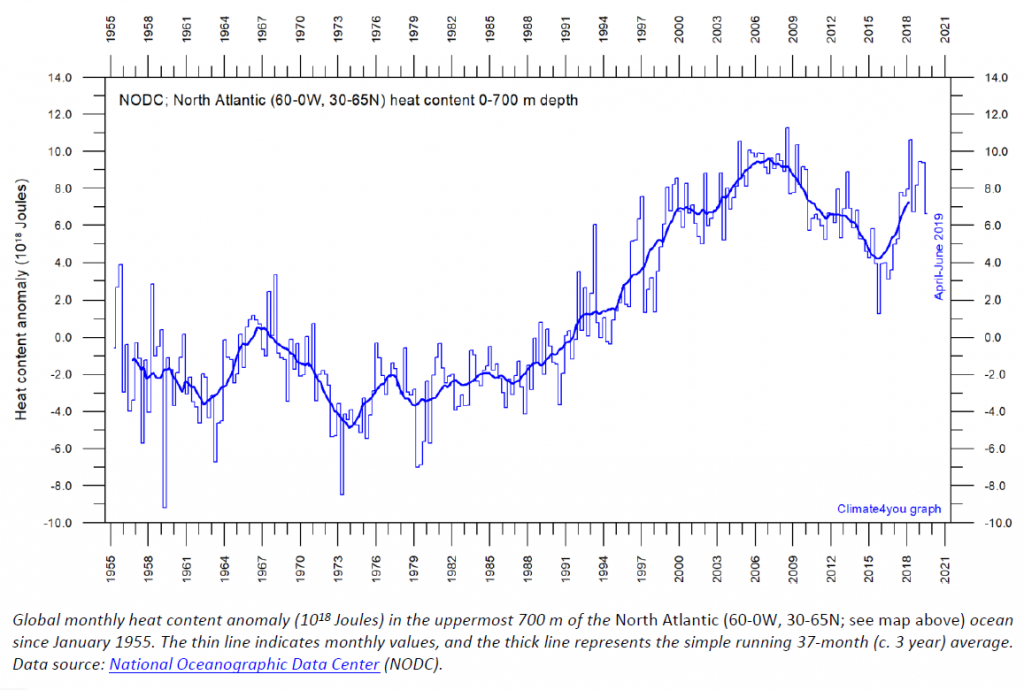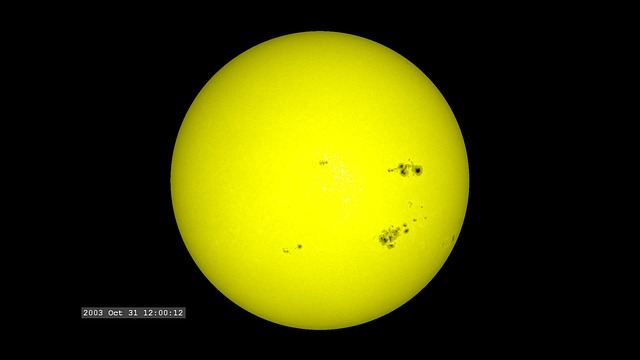Die Oberflächen-Temperatur der Ozeane lässt sich relativ leicht per Satellit oder Schiff ermitteln. Wie sieht es aber mit der Temperaturentwicklung tieferer Ozeanschichten aus? Der Fachbegriff hierzu lautet „ocean heat content“, oder kurz OHC. Im Jahr 2017 zeigten Dan Seidov und Kollegen, dass sich der OHC im Nordatlantik quasi-zyklisch im 60-80 Jahrestakt verändern. Taktgeber ist die Atlantische Multidekadenoszilation (AMO):
Multidecadal variability and climate shift in the North Atlantic Ocean
Decadal variability of ocean heat content (OHC) and temperature trends over ~60 years in the North Atlantic Ocean were analyzed using a new high‐resolution ocean climatology based on quality‐controlled historic in situ observations. Тwo ~30 year ocean climates of 1955–1984 and 1985–2012 were compared to evaluate the climate shift in this region. The spatial distribution of the OHC climate shift is highly inhomogeneous, with the climate shift being the strongest southeast of the Gulf Stream Extension. This may be caused by the Atlantic Meridional Overturning Circulation slowdown in conjunction with heaving of warm subtropical water. The 30 year climate shift shows higher OHC gain in the Gulf Stream region than reported in shorter timescale estimates. The OHC change is generally coherent with the Atlantic Multidecadal Oscillation index. This coherence suggests that quasi‐cyclicity of the OHC may exist, with a period of 60 to 80 years, superimposed on the slow basin‐wide warming trend.
In einem anderen Paper analysierten Piecuch et al. 2017 den OHC im subpolaren Nordatlantik. Auch hier wurde eine hohe natürliche Variabilität gefunden, die jedoch nicht direkt an die AMO gekoppelt zu sein scheint. Auszug aus dem Abstract:
Mechanisms underlying recent decadal changes in subpolar North Atlantic Ocean heat content
The subpolar North Atlantic (SPNA) is subject to strong decadal variability, with implications for surface climate and its predictability. In 2004–2005, SPNA decadal upper ocean and sea‐surface temperature trends reversed from warming during 1994–2004 to cooling over 2005–2015. This recent decadal trend reversal in SPNA ocean heat content (OHC) is studied using a physically consistent, observationally constrained global ocean state estimate covering 1992–2015. The estimate’s physical consistency facilitates quantitative causal attribution of ocean variations. Closed heat budget diagnostics reveal that the SPNA OHC trend reversal is the result of heat advection by midlatitude ocean circulation.
Weiterlesen bei Piecuch et al. 2017
Passend hierzu die Temperaturentwicklung des nördlichen Nordatlantiks für die obersten 700 m (via Climate4You):

Gehen wir weiter zum Pazifik. Dort scheint der 11-jährige Sonnenfleckenzyklus einen Enfluss auf den OHC zu haben, wie Wang et al. 2015 publizierten:
Decadal variability of upper ocean heat content in the Pacific: Responding to the 11-year solar cycle
Ocean heat content anomaly (OHCa) time series in some areas of the Pacific are significantly correlated with the total solar irradiance (TSI). Using the composite mean-difference method, we determined the mean response of OHCa in the upper-700 m of the ocean to the TSI. Among the high solar response areas, we figure out two regions, one in the tropical mid-Pacific and the other in the western Pacific, where the OHCa present decadal variations, but different phases. The variation in phase of the solar response indicates that there exists an agency for the OHCa’s response to TSI.
Linsley et al. 2015 beschrieben eine natürliche Variabilität des OHC im Südpazifik für die vergangenen 200 Jahre mit wechselnder Korrelationspolarität. Abstract:
Decadal changes in South Pacific sea surface temperatures and the relationship to the Pacific decadal oscillation and upper ocean heat content
Decadal changes in Pacific sea surface temperatures (SSTs) and upper ocean heat content (OHC) remain poorly understood. We present an annual average composite coral Sr/Ca‐derived SST time series extending back to 1791 from Fiji, Tonga, and Rarotonga (FTR) in the Pacific Decadal Oscillation (PDO) sensitive region of the southwest Pacific. Decadal SST maxima between 1805 and 1830 Common Era (C.E.) indicate unexplained elevated SSTs near the end of the Little Ice Age. The mean period of decadal SST variability in this region has a period near 25 years. Decades of warmer (cooler) FTR SST co‐occur with PDO negative (positive) phases since at least ~1930 C.E. and positively correlate with South Pacific OHC (0–700 m). FTR SST is also inversely correlated with decadal changes in equatorial Pacific SST as measured by coral Sr/Ca. Collectively, these results support the fluctuating trade wind‐shallow meridional overturning cell mechanism for decadal modulation of Pacific SSTs and OHC.
Bova et al. 2016 untersuchten die Temperaturgeschichte des östlichen Zentralpazifiks und fanden während der vergangenen 10.000 Jahre Beispiele für schnelle Erwärmungssprünge von mehr als 2°C innerhalb von nur 200 Jahren.
In einer ähnlichen Studie aus dem äquatorialen Pazifik von Rosenthal et al. 2017 fanden die Forscher, dass die Wassermassen in der Mitte der Wassersäule vor einigen tausend Jahren 1,5-2°C wärmer waren als heute. Dies entspricht dem Holozänen Thermischen Maximum (HTM). Die Highlights der Untersuchung:
A paleo-perspective on ocean heat content: Lessons from the Holocene and Common Era
Here we review proxy records of intermediate water temperatures from sediment cores in the equatorial Pacific and northeastern Atlantic Oceans, spanning 10,000 years beyond the instrumental record.
These records suggests that intermediate waters were 1.5–2 °C warmer during the Holocene Thermal Maximum than in the last century.
Intermediate water masses cooled by 0.9 °C from the Medieval Climate Anomaly to the Little Ice Age.
The records suggest that dynamic processes provide an efficient mechanism to amplify small changes in insolation into relatively large changes in OHC.
Over long time periods the ocean’s interior acts like a capacitor and builds up large (positive and negative) heat anomalies that can mitigate or amplify small radiative perturbations as seen in the Holocene trend and Common Era anomalies, respectively.
Evidently the ocean’s interior is more sensitive to small external forcings than the global surface ocean because of the high sensitivity of heat exchange in the high-latitudes to climate variations.
Zum Kontext hier noch die Temperaturentwicklung der Ozeane während der letzten 500 Millionen Jahre, dokumentiert von Veizer & Prokoph 2015:
Temperatures and oxygen isotopic composition of Phanerozoic oceans
The temperature of ancient oceans is an important constraint for understanding the climate history of our planet. The classical oxygen isotope paleothermometry on fossil shells, while very proficient when applied to the younger (Cenozoic) portion of the geologic record, is believed to yield only unreliable results for the Phanerozoic “deep time”, either because the empirically well documented secular trend to more negative δ18O values with increasing age was generated by post-depositional recrystallization processes or, if primary, implies ecologically unpalatable hot early oceans. Here we present a compilation of δ18O measurements for 58,532 low-Mg calcite marine shells that cover almost the entire Phanerozoic eon, argue that the secular decline of about − 6‰ is primary, propose that it reflects the changing oxygen isotopic composition of sea water, and define a new baseline trend for δ18O of paleo-sea water; the latter providing a new template for calculation of ambient habitat temperatures of fossil specimens. The resulting pattern for fossil taxa (foraminifera, brachiopods, belemnites and bivalves) mimics their modern counterparts in temperature ranges and modes. This conceptual framework enables application of actualistic concepts to ambient habitat temperatures of fossils and provides us with a long overdue tool for interpretation of “deep time” geologic history.
Abbildung aus dem Paper (Abkühlung=Ausschläge nach oben, Erwärmung=Ausschläge nach unten):

